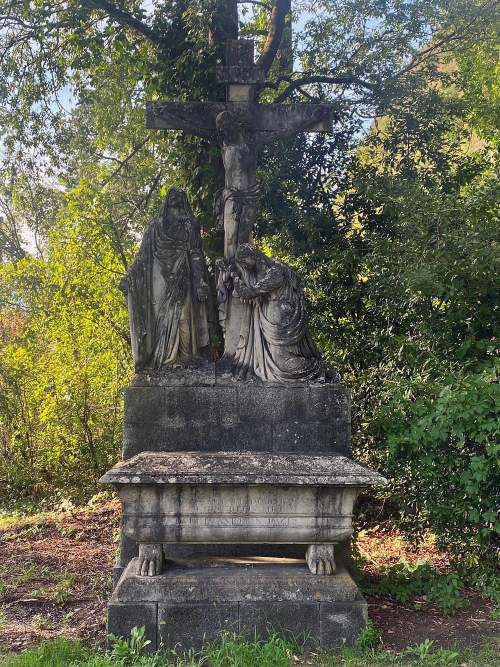 In Issue No. 169 of Salve Maria Regina, within the article on Our Lady's Title of
In Issue No. 169 of Salve Maria Regina, within the article on Our Lady's Title of Morning Star, we related the following:
 In Issue No. 169 of Salve Maria Regina, within the article on Our Lady's Title of
In Issue No. 169 of Salve Maria Regina, within the article on Our Lady's Title of Morning Star
, we related the following:
Our Lady of Light
was an old title of Hers in the Middle Ages. It is said that She Herself suggested that title to St. Thomas of Canterbury.
There was a Confraternity of Our Lady of Light, and St. Francis Xavier and his companions were enrolled in it before they set out for the Indies.
The Confraternity of Our Lady of Light, Spouse of the Holy Ghost was founded in England, in 1824. Pope Leo XIII indulgenced this prayer:
Our Lady of Light, Spouse of the Holy Ghost, I give Thee my whole self, soul and body, all I have or may have, to keep for Jesus that I may be His forever more.
Our Lady of Light, Spouse of the Holy Ghost, pray for me.
Other sources shed more light on the details of the English Confraternity mentioned above. It would seem that 1824 was the approximate date of the establishment of a domestic chapel, the predecessor of the National Shrine of Our Lady of Light – the Confraternity coming into existence much later. In 1953, Fr. C. Wilson OSC wrote concerning the origins of the Shrine:
The English Shrine of Our Lady of Light was founded in 1834, by Miss Ann Letitia Trelawny and her sister Mrs. Mary Harding, in accordance with the wish of their father, Sir Henry Trelawny.
Sir Henry Trelawny, seventh baronet of Trelawne in Cornwall, and member of an ancient and illustrious house, had for many years been a clergyman in the Church of England. An ardent seeker after truth, he later became a Non-conformist, but having come into contact with the Catholic Church, through giving constant hospitality to French emigré bishops and priests, he was eventually received into the Church, and in 1830, at the age of seventy-four, was ordained priest by Cardinal Odescalchi, Vicar of Pope Gregory XVI. He died at Laveno on February 25th, 1834 (monument – image right). His daughters had long been Catholics, and had already turned the old domestic chapel at Trelawne, originally dedicated by an ancestor, Dr. John Trelawny, Bishop of Exeter, into a Catholic chapel, but, after their father's death, they strove to overcome every obstacle to fulfil his last wish – the erection of a chapel on the estate dedicated to Our Lady of Light. It was his constant wish that Our Blessed Lady would bring to his beloved Cornwall that light of Faith that he himself had received. The chapel was built overlooking Talland Bay, and was opened on October 6th, 1843.
For a considerable time Sir Henry and his daughters had lived in Brittany, at Saint-Pol-de-Léon, and there had learned the True Devotion to the Blessed Virgin
of St. Louis-Marie de Montfort, and also the Title Our Lady of Light
, so beloved of the Saint; for near their home there was a shrine, known in the Breton tongue as
INTRON VARIA AR SKLERDER
, Our Lady of Light
. This chapel had been rebuilt and blessed on August 5th, 1837, by the Abbé Chauvel, the same priest who had said
the first Mass in the restored chapel at Trelawne in 1830. The shrine, as several other such shrines under the same dedication in Brittany, had long been frequented by pilgrims,
especially by those suffering from blindness and troubles of the sight, whether physical or spiritual, and as such had become very dear to the Trelawnys with their new sight of faith,
and had determined them to do for Cornwall, what Brittany had so long enjoyed. With this same idea in mind, they renamed the estate at Trelawne, Sclerder
,
which word is both Breton and Cornish for Light
.
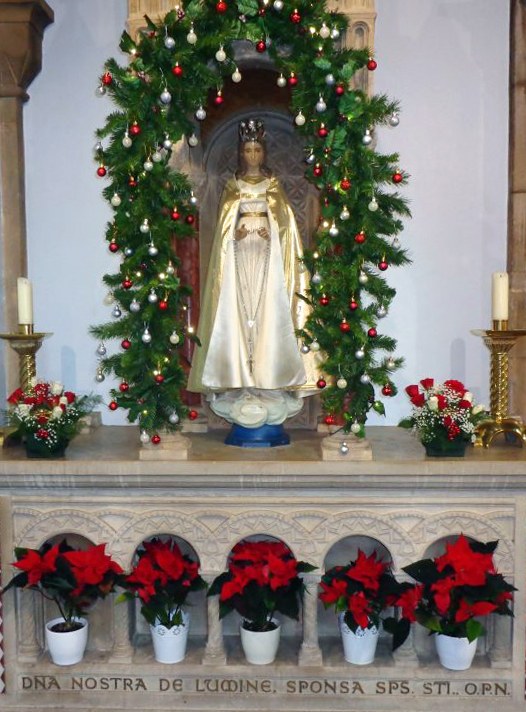 In the course of time the Catholic Trelawnys began to die out, Miss Ann Trelawny dying in 1860. For some years the chapel was served by priests,
both secular and Religious. Then, after many changes, and a period when the shrine seemed to be doomed to die out too, there came to Sclerder a Richard Lerins de Bary,
of Weston Hall, Worcester, with his wife and children, and with them the intention of furthering the Faith in Cornwall. Mr. de Bary did not live long enough to see his
desire fulfilled, but his wife, Pauline, had been attracted to the devotion to Our Lady of Light, and after restoring the chapel, brought there a beautiful statue of Our Lady,
carved in wood, and asked permission for an Association to be formed. The permission was granted on the fourteenth of May 1893, when Bishop Graham solemnly inaugurated the
festival of the titular:
In the course of time the Catholic Trelawnys began to die out, Miss Ann Trelawny dying in 1860. For some years the chapel was served by priests,
both secular and Religious. Then, after many changes, and a period when the shrine seemed to be doomed to die out too, there came to Sclerder a Richard Lerins de Bary,
of Weston Hall, Worcester, with his wife and children, and with them the intention of furthering the Faith in Cornwall. Mr. de Bary did not live long enough to see his
desire fulfilled, but his wife, Pauline, had been attracted to the devotion to Our Lady of Light, and after restoring the chapel, brought there a beautiful statue of Our Lady,
carved in wood, and asked permission for an Association to be formed. The permission was granted on the fourteenth of May 1893, when Bishop Graham solemnly inaugurated the
festival of the titular: Our Lady of Light, Spouse of the Holy Ghost
, recently granted by Rome; the feast to be kept on the Sunday within the Octave of the Ascension.
The statue (image left), which was the center of this shrine, is of unusual appearance. It represents Our Lady as very young and with a graceful dignity,
expressing Her utter purity. The hands, which are exquisitely formed, are turned, palms downwards before Her, as though bestowing blessings on Her suppliant children; while over Her,
there hovers a golden dove, symbol of the Holy Ghost, the Spirit of God, and the source of those blessings. Many have remarked on the likeness between this statue and
that of Our Lady of Fatima, which it precedes by thirty years, and it is worthy of note that the position of the hands is identical with the position of Our Lady's hands,
as described by the three children, when rays of light flowed from Her hands into them.
The chaplain in charge of the shrine took great interest in the devotion, and soon there grew a flourishing Association of Our Lady of Light. Sclerder was becoming a place of pilgrimage for Cornish Catholics, just as Sir Henry Trelawny had desired, and also a recognized Catholic center, at a time when Catholics in the south of England were widely scattered. However various difficulties still arose, so insurmountable apparently, that finally it was decided by Mrs. de Bary and Mrs. St. John that the only solution, would be to leave Sclerder, find another site for the shrine, and another headquarters for the Association. But the question was, where?
Clacton-on-Sea is, comparatively speaking, a new town. Too near the sea for our forefathers, who preferred a strip of dry land between themselves and the possible dangers that came by sea, modern Clacton grew into a town only towards the middle of the 19th century, owing to the then recent fashion of seaside holidays. Consequently, Clacton-on-Sea has no ecclesiastical history, but the surrounding ancient villages of Great Clacton, Little Clacton and St. Osyth are soaked in it. Each has its parish church, built by our forefathers for the celebration of Mass and the administration of the Sacraments.
The whole of this area, in Catholic times, must have been well cared for spiritually, coming, as it did, under the religious influence of the Augustinian Abbey of St. Osyth. Indeed the very name of this abbey gives us a clue as to the early date at which religion was flourishing here. Whatever is, or is not known of St. Osyth, it would seem certain that she was Abbess of a convent in this village named after her, in Saxon days, and that, she met a martyr's death at the hands of marauding Danes. Devotion to this Virgin Martyr must have been considerable in ancient days, in this neighborhood, as to a heroine, who counted her life as cheap in return for the preservation of her integrity and her Faith. What more do we need to know of her? Had the men who succeeded her in authority over the selfsame plot of land, been imbued with her spirit, then might her village have known greater glory, and her memory have been preserved as it should, instead of being lost in legend.
For the site of St. Osyth's convent became, eventually the site of an Abbey of men, following the rule of St. Augustine. For many years it flourished as a Major Abbey, the center of learning, culture, hospitality and charity for miles around. If, in those days, the man of Clacton needed a school for a boy, a letter to be written or read, medicine for the sick, a night's shelter for a traveler, legal advice, food and clothing for a beggar, or a score of other things, as well as spiritual ministrations, it was to the Abbey of St. Osyth that he made his way, and with no after taste of pauperization from what he had received; for it was the men of God, not giving of their own, but administering only the gifts of God.
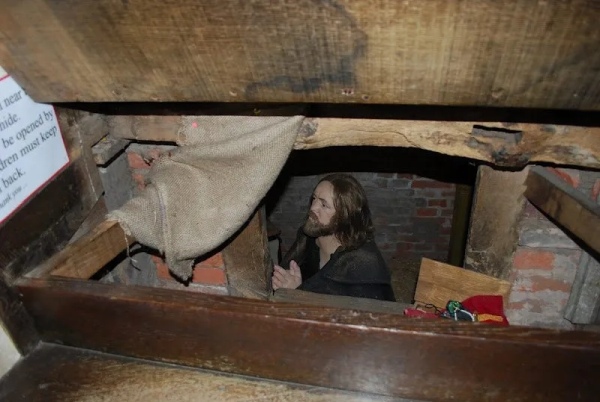 All this came to an end when Henry VIII dissolved the monasteries of England and confiscated for himself and his minions, the treasury of the poor.
The Abbey of Saint Osyth was handed over, without protest, by a weak Abbot; and was then handed by Henry to Thomas Cromwell as a reward for services rendered.
It was not many years after the monks had left St. Osyth, that even a greater change came about, the great change in the religious beliefs of England, known as the Reformation.
For the re-formation was not by any means in morals, though that was used as the chief excuse, but a fundamental change in those beliefs and practices, which Englishmen had held sacred,
from the time when Saint Augustine had first brought them to this land. The most sacred of these beliefs, and the one that was, under Elizabeth, the most severely attacked,
was the Holy Sacrifice of the Mass, in fact, the whole of the Catholic belief in the Holy Eucharist. Death was the penalty, not in theory but in fact,
for a priest to be in the country at all, and of course for saying Mass, as also for those who harbored a priest (Priest's hiding hole – image right).
The number of priests dwindled to a mere handful of courageous men, whose parish was the whole country, who lived constantly with death, and that death to be drawn on a
hurdle to the place of execution, there to be hanged by the neck, and often while still conscious to be quartered by the hangman's knife. All for the Mass!
for the Mass that was no longer said in the parish churches of Great Clacton, Little Clacton and St. Osyth. The statues of the Virgin Mother were ordered to be removed,
and also, we can imagine, any of St. Osyth, and the people forbidden even to respect the objects which their forefathers had deeply revered for a thousand years.
It is not many years ago since the old stone altar-table of the parish church of St. Osyth, was found, forming part of the path outside the church.
For three hundred years Mass was not said in the Clacton district, at least publicly, and three hundred years is a long time, ample time to forget.
All this came to an end when Henry VIII dissolved the monasteries of England and confiscated for himself and his minions, the treasury of the poor.
The Abbey of Saint Osyth was handed over, without protest, by a weak Abbot; and was then handed by Henry to Thomas Cromwell as a reward for services rendered.
It was not many years after the monks had left St. Osyth, that even a greater change came about, the great change in the religious beliefs of England, known as the Reformation.
For the re-formation was not by any means in morals, though that was used as the chief excuse, but a fundamental change in those beliefs and practices, which Englishmen had held sacred,
from the time when Saint Augustine had first brought them to this land. The most sacred of these beliefs, and the one that was, under Elizabeth, the most severely attacked,
was the Holy Sacrifice of the Mass, in fact, the whole of the Catholic belief in the Holy Eucharist. Death was the penalty, not in theory but in fact,
for a priest to be in the country at all, and of course for saying Mass, as also for those who harbored a priest (Priest's hiding hole – image right).
The number of priests dwindled to a mere handful of courageous men, whose parish was the whole country, who lived constantly with death, and that death to be drawn on a
hurdle to the place of execution, there to be hanged by the neck, and often while still conscious to be quartered by the hangman's knife. All for the Mass!
for the Mass that was no longer said in the parish churches of Great Clacton, Little Clacton and St. Osyth. The statues of the Virgin Mother were ordered to be removed,
and also, we can imagine, any of St. Osyth, and the people forbidden even to respect the objects which their forefathers had deeply revered for a thousand years.
It is not many years ago since the old stone altar-table of the parish church of St. Osyth, was found, forming part of the path outside the church.
For three hundred years Mass was not said in the Clacton district, at least publicly, and three hundred years is a long time, ample time to forget.
We do not dwell on these things in a spirit of bitterness, but that we might remember and understand what the Mass has always meant and still means to a Catholic.
It must be well nigh a hundred years since the Mass came back to Clacton, and this time not to the ancient villages, but to the modern Clacton-on-Sea, when a few 'coastguards' met, with an unknown priest, Sunday by Sunday, in the Martello Tower.
Nothing is known of them; just a handful of stalwarts, who kept their faith alive, and in so doing, sowed a seed for generations still unborn. The story of the restoration of the Faith to Clacton must be similar to the story of many small towns of those days: little people striving heroically to keep the Faith alive in themselves, and to pass on to their children the traditions of Catholic life; hopes fed and disappointments overcome, till they won through by prayer and determination. This story is told here simply, in the unvarnished manner in which the present writer found it, written in an old exercise book. It may not record an important historical event, nor be of vital interest to the general reader, but as the story of ordinary folk making a heroic effort for their belief, it cannot fail to have its appeal:
"For a long time after the Mass ceased to be said in the Martello Tower, Clacton was again deserted; and then it was said a few times in the Royal Hotel, through the influence of a Catholic gentleman who was staying there. Later we hear of Mass being said at Loretto House, but through whose kind office we know not. Yet again the O'Briens, an Irish family, living in West Avenue, had Mass said a few times, by a priest from Colchester. Again a long blank. And then, bringing the date up to 1890, the Moriarty family arranged for a priest to come for about six weeks. The chapel was a small room over Walker's fruit shop in Station Road; and the parallel between that small room and the Upper Chamber in Jerusalem, forced itself on the minds of those present. But though this development seemed the most promising yet, it was destined to come to an early end. The numbers were miserably small and so the attempt to establish a regular Sunday Mass was abandoned.
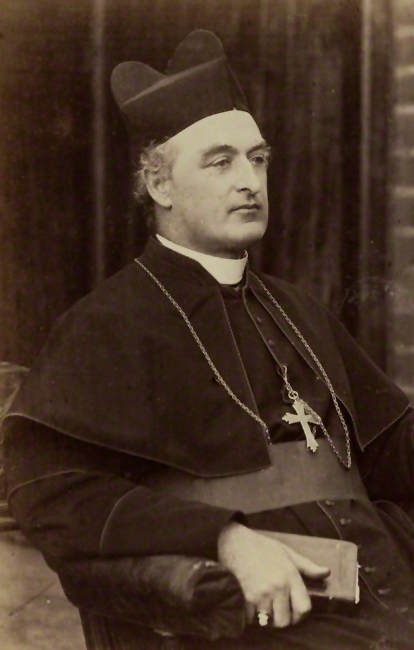 Two years later the Moriartys wrote to Herbert Cardinal Vaughan (image left), Archbishop of Westminster (the diocese of Brentwood had not then been formed),
asking if he could not send a delegate priest, whom they would be prepared to receive and keep according to their means. Eventually they were promised a Sunday Mass,
if they could guarantee an attendance of not less than twenty people. Failing to find the required number in Clacton, children were brought from Colchester,
and the Mass was said in the tiny Wesleyan Chapel. It was a grand occasion. Both priest, Father Biali, and choir, as well as many of the congregation, were supplied by Colchester.
Two years later the Moriartys wrote to Herbert Cardinal Vaughan (image left), Archbishop of Westminster (the diocese of Brentwood had not then been formed),
asking if he could not send a delegate priest, whom they would be prepared to receive and keep according to their means. Eventually they were promised a Sunday Mass,
if they could guarantee an attendance of not less than twenty people. Failing to find the required number in Clacton, children were brought from Colchester,
and the Mass was said in the tiny Wesleyan Chapel. It was a grand occasion. Both priest, Father Biali, and choir, as well as many of the congregation, were supplied by Colchester.
The mission in Clacton would seem to have started in earnest, and success might have been expected from the very persistence of these pioneers, but it was not to be. The difficulty of finding the requisite number every week, increased instead of diminishing, and Father Biali was reluctantly forced to admit that the position was hopeless. The tabernacle was taken away! One thing only remained to the Catholics of Clacton, the crucifix from the altar, and this Mrs. Moriarty begged to retain as a sign and a hope for better days.
However there was not a total break; and Mass was said a few times in the Moriartys’ house. Then with the further development of the town, the numbers began to increase. The hall of the (old) Town Hall Offices was hired, and Father Bellord, a military chaplain and later Bishop, came from Colchester. On the first Sunday morning there were nineteen people present, and to make up the number, a non-Catholic baby was borrowed from a neighbor of the Moriartys. This baby, Hilda Franks, later on became a Catholic and a nun. The cause of religion prospered. There are few alive today, who remember the scenes of excitement which greeted the priest on his arrival from Colchester, especially if he happened to be late. The line might be flooded, or other catastrophe happen, in which case, Father Bellord was obliged to commandeer a carriage. Loud and hearty were the cheers which greeted him, when in nick of time, he drove down the High Street at a furious pace.
The growing success of the Catholics was not unobserved, and a certain amount of opposition was making itself felt. Meetings were held in a chapel in the town, to pray for expulsion of Roman Catholics and Jews. On the night before what was to have been a monstrous demonstration against Catholics, the Chapel people sustained great misfortune. Owing to overheating and faulty construction, the place caught fire and was severely damaged.
Meantime the self-sacrifice and energy of the Catholics knew no bounds. Mr. Moriarty, grand old man that he was, gave up the small comforts by which men set such store, including his tobacco, and devoted the money thus saved to paying the town-crier to announce Mass every week. Father Bellord and he scoured Frinton, Walton and St. Osyth, and found a number of Catholics including a number of children. Thus the attendances at the Sunday Masses and Catechism were somewhat increased.”
As we have already seen, it was at the end of 1894 that Mrs. Pauline de Bary and her companion Mrs. Agnes St. John left Sclerder. At once they approached Cardinal Vaughan for advice as to where they should re-erect the shrine of Our Lady of Light. His Eminence, remembering the appeal of the Moriartys for a priest, suggested Clacton-on-Sea. Accordingly the ladies set out for Clacton, together with their precious statue of Our Lady of Light, and at once set about acquiring a piece of land. At first it seemed as though there would be no land available. When the town had been planned, sites had been set aside for churches, and the Council had offered one to Cardinal Vaughan, but the Cardinal could not, at that time, see any possibility of development for the Church in Clacton. The only suitable land, now to be found, was outside the town, and this was almost secured when, unexpectedly, the plot of land, at the junction of Church and Holland Roads, came into the market. The ladies bought it for £2,400, and also the house standing on it. On taking up residence they renamed the house "Montfort", after St. Louis-Marie de Montfort, through whom the devotion to Our Lady of Light had returned to England.
Here were real beginnings at last! But again difficulties arose. The ladies, for some reason now unknown, became discouraged. Perhaps it was the difficulty in getting a regular priest. In October 1895, they approached the Oblates of Saint Charles, of Bayswater, asking if they would undertake to care for the shrine and foster the devotion, as they themselves wished to leave Clacton.
The Oblates of Saint Charles are a Congregation of Secular Priests, founded in England by Cardinal Manning, and who are pledged to undertake such work as their
bishop desires. They had then not long been founded, in fact Cardinal Vaughan himself had been one of the first members. He, therefore readily agreed to their taking up
this work not only because he wished to provide for the spiritual needs of Clacton, but also because he strongly approved of the True Devotion to the Blessed Virgin
of St. Louis-Marie de Montfort. In fact, as Bishop of Salford, he had sent a letter to his clergy and people encouraging this devotion; a letter, which even now,
is constantly quoted in publications on the subject.
On the feast of Saint Charles, November 4th 1895, it was announced that the Cardinal had given his consent to the mission in Clacton being handed over to the Oblates,
and that he had already begun to erect the Confraternity of Our Lady of Light there canonically. The Oblate Fathers officially accepted the charge and sent, as the first priest,
Father Alfred Swaby, who was to continue as Parish Priest for the next twenty years. Mass was being said, at this time, in the dining room of Montfort,
but as this was becoming too small, new premises, containing a small hall for a chapel, now called Montfort Lodge, were added. But still the congregation grew,
and on occasion, the new hall was filled to overflowing. The Father Superior of the Oblates, Canon Wyndham, announced to the Fathers in Chapter. in 1899:
This work of ours in Clacton is good, and the numbers are increasing. Last year thirty people received Holy Communion at Easter, this year one hundred and three received.
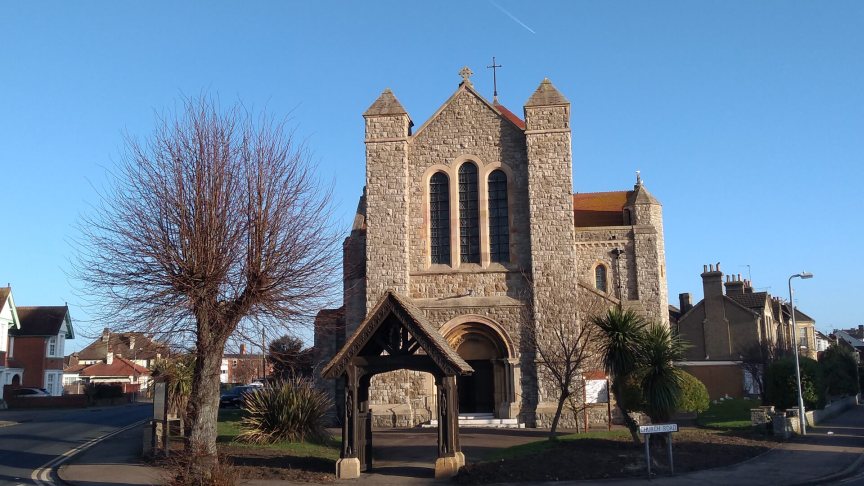
The future seemed assured. So much so that, in 1901, Father Swaby gave notice to the Chapter of the Oblates, that he wished to raise the subject of building
a permanent church in Clacton. The Fathers approved of the idea, and it was decided to build a church, or part of one at first for about £2,000, considering that such would
be enough to satisfy the needs of so small a place, and with so small a number of Catholics. However at a later date, Canon Wyndham again addressed the Community.
He had been paying frequent visits to Clacton, and had formed an idea as to what was really needed, to express adequately the notion of a shrine to Our Lady of Light,
as also the dignity of the Faith. He spoke, therefore, as follows: The building of a small church or a cheap one does not seem practical. For a place as isolated as Clacton,
the building itself should be expressive of the Holy Catholic Faith.
Meaning, presumably, her strong and sure foundation, and her ability to weather all storms.
Nor,
he continued, should they consider building only part of a church, because it had been presented to him that to provide a temporary closure at the end,
would be very expensive, and that there was always the danger that the old part would be found to have shrunk, when the new came to be added.
In consequence,
with that generosity which so many experienced, he himself offered to give a considerable sum to augment the money already received from subscriptions.
Father Richards then offered a further sum. However as a loan would still be needed, the Oblates promised to guarantee the interest, should the people of Clacton be unable to meet it.
An architect, Mr. F. W. Tasker, was approached, and in April 1902 work began on the new church (image above).
It was the particular function of the Confraternity of Our Lady of Light to foster the practice of the Total Consecration to Jesus through Mary as taught by St. Louis-Marie de Montfort. Pope Leo XIII granted an indulgence for the recitation of the prayer mentioned at the beginning of this article at the request of the newly-founded Confraternity.
Additional Article on Our Lady of Guadalupe
Alphabetical Index; Calendar List of Saints
Contact us: smr@salvemariaregina.info
Visit also: www.marienfried.com